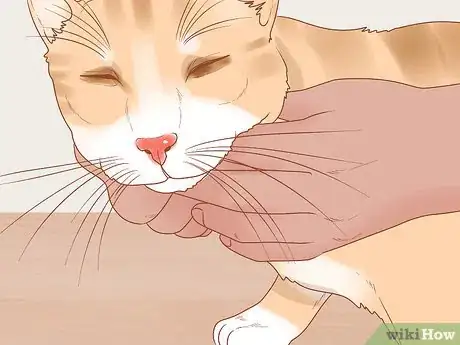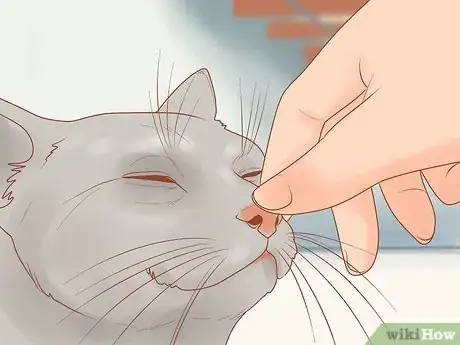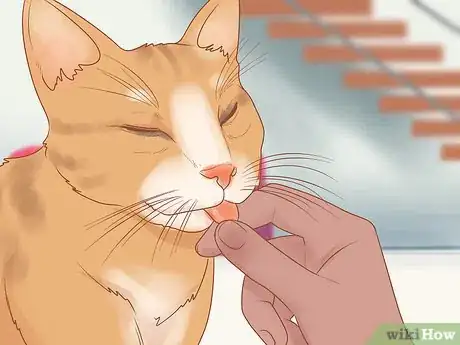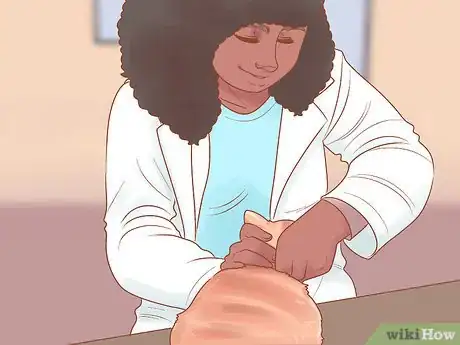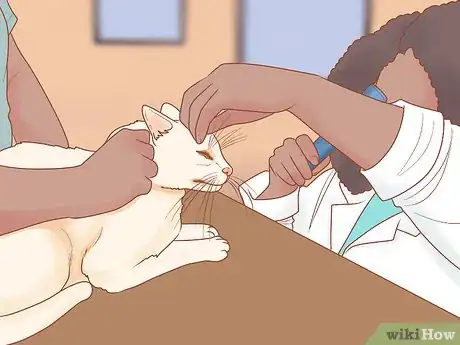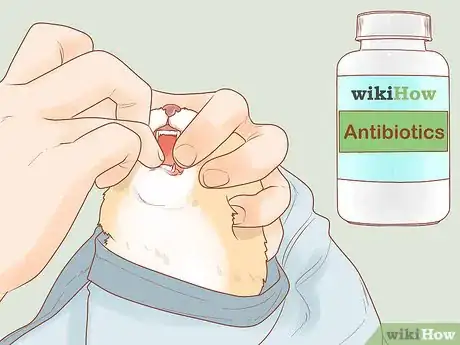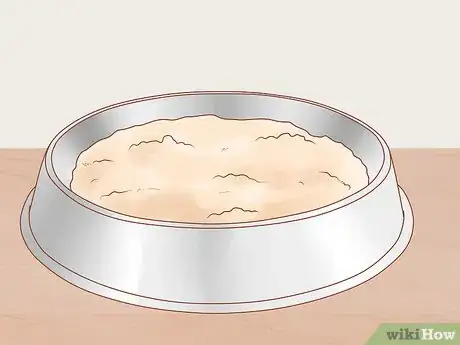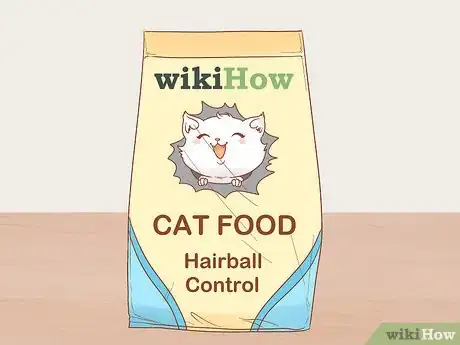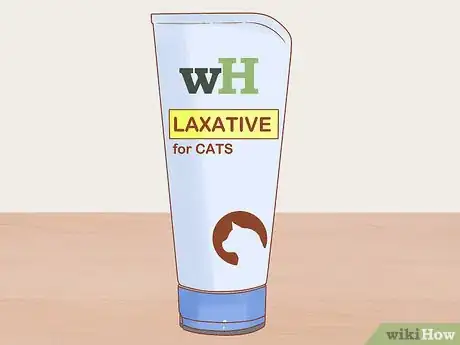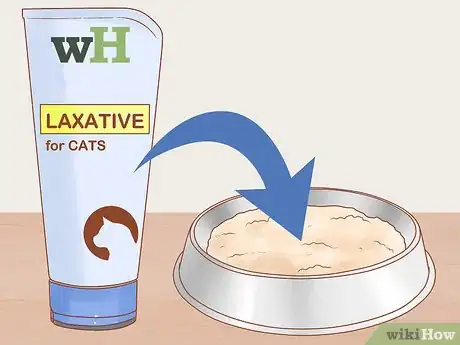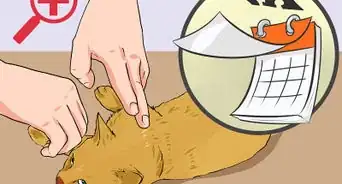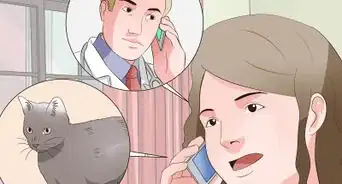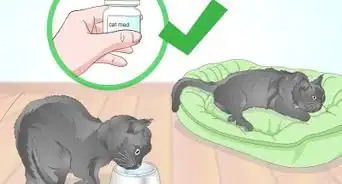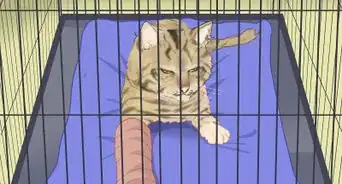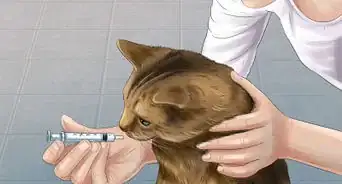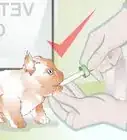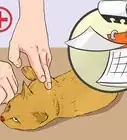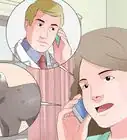This article was co-authored by Pippa Elliott, MRCVS. Dr. Elliott, BVMS, MRCVS is a veterinarian with over 30 years of experience in veterinary surgery and companion animal practice. She graduated from the University of Glasgow in 1987 with a degree in veterinary medicine and surgery. She has worked at the same animal clinic in her hometown for over 20 years.
This article has been viewed 49,195 times.
Gagging in cats may occur for different reasons. It commonly happens with hairballs, but more serious conditions like infections or inflammation can also cause gagging. To treat gagging due to medical problems, take your cat to the vet and administer the proper medication. To help with gagging due to hairballs, try feeding your cat food that will help it digest better, and groom it more often. Massage your cat’s throat and help it swallow to help with gagging.
Steps
Helping a Gagging Cat
-
1Massage the throat. If your cat starts gagging and coughing like there is something caught in its throat, try massaging the throat. This can help relax the muscles so the cat will swallow and the muscles can stop spasming.[1]
-
2Place a hand over the nose. You may be able to help the cat stop gagging by helping it swallow whatever is irritating its throat. Cover the cat’s nose with your hand. This will cut off air from its nose and force it to swallow, which can help clear the throat.[2]Advertisement
-
3Hold down its tongue. Helping your cat get more air into its nose may help stop the gagging. Stick your finger into your cat’s mouth and gently hold down its tongue. This will cause more air to get into the nose, which can help clear whatever is making it gag.[3]
- Use caution with this method because your cat could bite your finger.
-
4Take your cat to the vet immediately if it shows signs of distress. Heavy drooling, confusion, difficulty breathing, or blue gums could all be signs that something serious is wrong with your cat. If you notice any of these symptoms, take your cat to the vet as soon as possible.
Treating Chronic Gagging
-
1Take your cat to the vet. If your cat has been gagging, there may be an underlying problem. Infections may cause gagging, or your cat may gag because of mucus or debris caught in its nasal passages or throat. Your vet can do an exam to see if the gagging is caused by an underlying condition.[4]
- Your vet might give your cat an anesthetic so they can examine its throat, so it's a good idea to not feed your cat for several hours before you take it in.
-
2Treat mucus with allergy medication. Sometimes, a cat will gag and have other involuntary respiratory reflexes because of mucus caused by allergies or irritation. To help clear this up, your vet may prescribe an antihistamine or decongestant for your cat that will help with the gagging.[5]
- If the gagging is connected with coughing, the vet may give the cat a cough suppressant.
-
3Treat infection or inflammation with medication. If your cat has a more serious problem, like an infection or inflammation, your vet may prescribe stronger medication. For infections, the cat will be given antibiotics. If the nasal passages or throat is inflamed and causing the cat to gag, it may be given steroids.[6]
-
4Use medication or surgery to treat structural damage. Gagging may be a result of structural damage to the throat area. If the damage is mild, the vet may prescribe muscle relaxers that help the cat use its muscles.[7]
- If the damage is severe, or if it has abscesses, your vet may recommend surgery to fix the damage.
-
5Feed your cat soft food. Softer cat food may help your cat swallow its food instead of gagging. You may temporarily switch to a soft food, or try adding warm water to dry food to make it mushy. Softer foods can go down the cat’s throat more easily.[8]
Preventing Hairballs
-
1Try a hairball formula cat food. Your cat may benefit from a cat food that’s specifically made for hairballs. This food contains ingredients that are supposed to help the hairballs move through the cat’s body so it won’t gag or vomit them up.[9]
- You can ask your vet for a formula recommendation or find one online or at a pet store.
-
2Brush your cat’s fur more often. If your cat is gagging due to too much hair, start brushing it more often. Try brushing its fur daily to remove loose hair. This may reduce the amount of hair your cat ingests when it grooms.[10]
- You may also want to wipe your cat’s coat with a damp cloth to remove any loose hair the brush didn’t get.
-
3Give your cat a digestive aid. You can talk to your vet about getting a laxative or other digestive aid that will help the hair and hairballs pass more easily through the digestive tract. These products contain some type of lubricant that helps hair avoid getting stuck.
-
4Mix foods that aid with digestion into your cat’s food. Hairballs can lead to gagging. Hairballs occur when your cat can’t digest the hair it has swallowed while grooming. To help reduce gagging and get the hair to go through your cat, try mixing one to two tablespoons of canned pumpkin into your cat’s food. This food has a lot of fiber, which can help your cat push the hair through.[11]
- Olive oil is another food product you can try. Add one teaspoon of olive oil to the food. This can aid in digestion, which can reduce gagging.
- You can add these foods once or twice a week to your cat’s food.
References
- ↑ https://www.canidae.com/blog/2010/02/what-is-reverse-sneezing-and-is-it-dangerous/
- ↑ https://www.canidae.com/blog/2010/02/what-is-reverse-sneezing-and-is-it-dangerous/
- ↑ https://www.canidae.com/blog/2010/02/what-is-reverse-sneezing-and-is-it-dangerous/
- ↑ http://www.petmd.com/cat/conditions/respiratory/c_ct_sneezing?page=2
- ↑ http://www.petmd.com/cat/conditions/respiratory/c_ct_sneezing?page=2
- ↑ https://www.vetary.com/cat/condition/swallowing-difficulties
- ↑ https://www.vetary.com/cat/condition/swallowing-difficulties
- ↑ https://www.vetary.com/cat/condition/swallowing-difficulties
- ↑ http://www.onegreenplanet.org/animalsandnature/simple-home-remedies-to-reduce-cat-hairballs/
About This Article
To help a gagging cat, try massaging its throat to relax the muscles and stop them from spasming. Alternatively, cover the cat’s nose with your hand, which will cut off the air and force it to swallow. You could also try gently sticking your finger into its mouth and holding down its tongue to get more air into its throat. If your cat shows signs of distress, like heavy breathing, drooling, or bluish gums, take it to your vet immediately for a check up. To learn more, including how to treat chronic gagging in your cat, keep reading!
